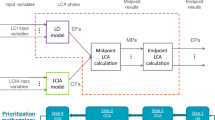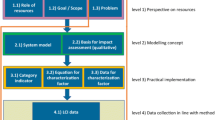Abstract
Purpose
The planetary boundaries framework contains regional boundaries in addition to global boundaries. Geographically resolved methods to assess regional environmental impacts are therefore needed. Existing planetary boundaries-based life cycle assessment (PB-LCA) methods have limited geographical resolution or are not applicable to full product systems, due to high spatial requirements on inventory data. Here, we enable PB-LCA of full product systems across a comprehensive set of regional and global PB impact categories.
Methods
We propose comparing environmental impacts of individual processes within a product system to assigned shares of regional or global safe operating space (SOS). This is followed by aggregation of process-level results so that accumulated exceedance of assigned SOS is derived across the entire life cycle. We then present a procedure for aggregating geographically resolved characterization factors (CFs) and SOS to country, continent and global levels, ensuring compatibility with typical life cycle inventory results. We then apply the new techniques to a model laundry case study. It involves 61 selected processes, two geographically resolved PB-LCA methods, related to impacts from freshwater use and nitrogen emissions, and a largely spatially generic PB-LCA method that covers a comprehensive set of impact categories.
Results and discussion
The calculation of accumulated exceedance of assigned SOS may help inform decisions about where in a life cycle to focus impact reduction efforts most urgently. The number of case study processes that exceed their assigned SOS differs when applying the geographically resolved methods, as opposed to the largely spatially generic method. Case study results differ greatly across PB-LCA impact categories, reaffirming the importance of covering a comprehensive set. Geographically resolved methods are needed for all regional impact categories and software support would be advantageous. Existing methods will require periodic updates to reflect ongoing advancements in PB science. Best practice approaches or a consensus for assigning regional SOS to processes are needed.
Conclusions and outlook
Our study provides a step towards greater operability of geographically resolved PB-LCA methods by enabling application to a full product system within an assessment that covers a comprehensive set of impact categories. The case study application shows potential advantages of the process-level approach and points to the need for quantifying uncertainties in such assessments. Future studies should seek to explore the potential role of PB-LCA in decision support compared with conventional LCA.





Similar content being viewed by others
References
Agez M, Wood R, Margni M, Strømman AH, Samson R, Majeau-Bettez G (2020) Hybridization of complete LCA and MRIO databases for a comprehensive product system coverage. J Ind Ecol 24:774–790
AISE (2015a) Pan-European Consumer Survey On Sustainability And Washing Habits - Summary Of Findings, 2014. International Association for Soaps, Detergents and Maintenance Products
AISE (2015b) PEF screening report in the context of the EU Product Environmental Footprint Category Rules (PEFCR) Pilots - household heavy duty liquid laundry detergents (HDLLD) for machine wash. International Association for Soaps, Detergents and Maintenance Products
Bjørn A, Sim S, King H, Keys P, Wang-Erlandsson L, Cornell S, Margni M, Bulle C (2019) Challenges and opportunities towards improved application of the planetary boundary for land-system change in life cycle assessment of products. Sci Total Environ 696:133964
Bjørn A, Chandrakumar C, Boulay A-M, Doka G, Fang K, Gondran N, Hauschild MZ, Kerkhof A, King H, Margni M, Mclaren S, Mueller C, Owsianiak M, Peters G, Roos S, Sala S, Sandin G, Sim S, Vargas-Gonzalez M, Ryberg M (2020a) Review of life-cycle based methods for absolute environmental sustainability assessment and their applications. Environ Res Lett 15:083001. https://doi.org/10.1088/1748-9326/ab89d7
Bjørn A, Sim S, Boulay A-M, King H, Clavreul J, Lam WY, Barbarossa V, Bulle C, Margni M (2020b) A planetary boundary-based method for freshwater use in life cycle assessment: development and application to tomato production case study. Ecol Indic 110:105865
Bjørn A, Sim S, King H, Margni M, Henderson A, Payen S, Bulle C (2020c) A comprehensive planetary boundary-based method for the nitrogen cycle in life cycle assessment: development and application to a tomato production case study. Sci Total Environ 715:136813
Brook BW, Ellis EC, Perring MP, Mackay AW, Blomqvist L (2013) Does the terrestrial biosphere have planetary tipping points? Trends Ecol Evol 28:396–401. https://doi.org/10.1016/j.tree.2013.01.016
Bulle C, Margni M, Patouillard L, Boulay AM, Bourgault G, De Bruille V, Cao V, Hauschild M, Henderson A, Humbert S, Kashef-Haghighi S, Kounina A, Laurent A, Levasseur A, Liard G, Rosenbaum RK, Roy PO, Shaked S, Fantke P, Jolliet O (2019) IMPACT World+: a globally regionalized life cycle impact assessment method. Int J Life Cycle Assess 24:1653–1674. https://doi.org/10.1007/s11367-019-01583-0
Eurostat (2008) Eurostat manual of supply, use and input--output tables. Methodologies and working papers. European Commission, Luxembourg
Fang K, Heijungs R, De Snoo GR (2015) Understanding the complementary linkages between environmental footprints and planetary boundaries in a footprint–boundary environmental sustainability assessment framework. Ecol Econ 114:218–226. https://doi.org/10.1016/j.ecolecon.2015.04.008
GFW (2019) Oil palm concessions. Global Forest Watch. Available: http://data.globalforestwatch.org/datasets/20398d4dc36e47bd92b559786670f270_1. Accessed 14 May 2019
Gleeson T, Erlandsson LW, Zipper SC, Porkka M, Jaramillo F, Gerten D, Fetzer I, Cornell SE, Piemontese L, Gordon L, Rockström J, Oki T, Sivapalan M, Wada Y, Brauman KA, Flörke M, Bierkens MFP, Lehner B, Keys P, Kummu M, Wagener T, Dadson S, Troy TJ, Steffen W, Falkenmark M, Famiglietti JS (2020) The water planetary boundary: interrogation and revision. One Earth 2:223–234
Kahiluoto H, Kuisma M, Kuokkanen A, Mikkilä M, Linnanen L (2015) Local and social facets of planetary boundaries: right to nutrients. Environ Res Lett 10:104013
Kummu M, Taka M, Guillaume JHA (2018) Gridded global datasets for gross domestic product and human development index over 1990 – 2015. Sci Data 5:180004
Lade SJ, Steffen W, de Vries W, Carpenter SR, Donges JF, Gerten D, Hoff H, Newbold T, Richardson K, Rockström J (2020) Human impacts on planetary boundaries amplified by Earth system interactions. Nat Sustain 3:119–128. https://doi.org/10.1038/s41893-019-0454-4
Lenton TM, Williams HTP (2013) On the origin of planetary-scale tipping points. Trends Ecol Evol 28:380–382. https://doi.org/10.1016/j.tree.2013.06.001
Mutel C, Liao X, Patouillard L, Bare J, Fantke P, Frischknecht R, Hauschild M, Jolliet O, De Souza DM, Laurent A, Pfister S (2019) Overview and recommendations for regionalized life cycle impact assessment. Int J Life Cycle Assess 24:856–865
Patouillard L, Bulle C, Querleu C, Maxime D, Osset P, Margni M (2018) Critical review and practical recommendations to integrate the spatial dimension into life cycle assessment. J Clean Prod 177:398–412. https://doi.org/10.1016/j.jclepro.2017.12.192
Patouillard L, Collet P, Lesage P, Tirado Seco P, Bulle C, Margni M (2019) Prioritizing regionalization efforts in life cycle assessment through global sensitivity analysis: a sector meta-analysis based on ecoinvent v3. Int J Life Cycle Assess 24:2238–2254. https://doi.org/10.1007/s11367-019-01635-5
PRé (2019) SimaPro V8.5.2.0. PRé Consultants
Randers J (2012) Greenhouse gas emissions per unit of value added (“GEVA”) — a corporate guide to voluntary climate action. Energy Policy 48:46–55
Rocha J, Peterson G, Bodin Ö, Levin SA (2018) Cascading regime shifts within and across scales. Science (80-) 362:1379–1383
Rockström J, Steffen W, Noone K, Persson A, Chapin FS, Lambin EF, Lenton TM, Scheffer M, Folke C, Schellnhuber HJ, Nykvist B, de Wit CA, Hughes T, van der Leeuw S, Rodhe H, Sorlin S, Snyder PK, Costanza R, Svedin U, Falkenmark M, Karlberg L, Corell RW, Fabry VJ, Hansen J, Walker B, Liverman D, Richardson K, Crutzen P, Foley JA (2009a) A safe operating space for humanity. Nature 461:472–475. https://doi.org/10.1038/461472a
Rockström J, Steffen W, Noone K, Persson Å, Stuart III, Chapin F, Lambin EF, Lenton TM, Scheffer M, Folke C, Schellnhuber HJ, Nykvist B, de Wit CA, Hughes T, van der Leeuw S, Rodhe H, Sörlin S, Snyder PK, Costanza R, Svedin U, Falkenmark M, Karlberg L, Corell RW, Fabry VJ, Hansen J, Walker B, Liverman D, Richardson K, Crutzen P, Foley JA (2009b) Planetary boundaries: exploring the safe operating space for humanity. Ecol Soc 14:32
Ryberg MW, Owsianiak M, Richardson K, Hauschild MZ (2016) Challenges in implementing a planetary boundaries based life-cycle impact assessment methodology. J Clean Prod 139:450–459. https://doi.org/10.1016/j.jclepro.2016.08.074
Ryberg MW, Richardson K, Hauschild MZ (2018a) Development of a life-cycle impact assessment methodology linked to the planetary boundaries framework. Ecol Indic 88:250–262. https://doi.org/10.1016/j.ecolind.2017.12.065
Ryberg MW, Owsianiak M, Clavreul J, Mueller C, Sim S, King H, Hauschild MZ (2018b) How to bring absolute sustainability into decision-making: an industry case study using a Planetary Boundary-based methodology. Sci Total Environ 634:1406–1416. https://doi.org/10.1016/j.scitotenv.2018.04.075
Stadler K, Wood R, Bulavskaya T, Södersten CJ, Simas M, Schmidt S, Usubiaga A, Acosta-Fernández J, Kuenen J, Bruckner M, Giljum S, Lutter S, Merciai S, Schmidt JH, Theurl MC, Plutzar C, Kastner T, Eisenmenger N, Erb KH, de Koning A, Tukker A (2018) EXIOBASE 3: developing a time series of detailed environmentally extended multi-regional input-output tables. J Ind Ecol 22:502–515. https://doi.org/10.1111/jiec.12715
Steffen W, Richardson K, Rockström J, Cornell SE, Fetzer I, Bennett EM, Biggs R, Carpenter SR, de Vries W, de Wit CA, Folke C, Gerten D, Heinke J, Mace GM, Persson LM, Ramanathan V, Reyers B, Sorlin S (2015) Planetary boundaries: guiding human development on a changing planet. Science (80-) 347:736. https://doi.org/10.1126/science.1259855
Wernet G, Bauer C, Steubing B, Reinhard J, Moreno-Ruiz E, Weidema B (2016) The ecoinvent database version 3 (part I): overview and methodology. Int J Life Cycle Assess 21:1218–1230
Willett W, Rockström J, Loken B, Springmann M, Lang T, Vermeulen S, Garnett T, Tilman D, Declerck F, Crona B, Fox E, Bignet V, Troell M, Lindahl T, Singh S, Cornell SE, Reddy KS, Narain S, Nishtar S, Murray CJL (2019) The Lancet Commissions Food in the Anthropocene: the EAT – Lancet Commission on healthy diets from sustainable food systems. Lancet 393:447–492. https://doi.org/10.1016/S0140-6736(18)31788-4
Acknowledgements
We thank Maxime Agez, Polytechnique Montréal, for extracting GVA data from Exiobase and for assisting with the linking of Ecoinvent processes and Exiobase products and the merging of Ecoinvent processes that occur within the same production facility. We also thank the two anonymous reviewers for their thoughtful comments.
Funding
This study received funding from Mitacs and Unilever.
Author information
Authors and Affiliations
Corresponding author
Additional information
Responsible Editor: Matthias Finkbeiner
Publisher’s note
Springer Nature remains neutral with regard to jurisdictional claims in published maps and institutional affiliations.
Rights and permissions
About this article
Cite this article
Bjørn, A., Sim, S., King, H. et al. Life cycle assessment applying planetary and regional boundaries to the process level: a model case study. Int J Life Cycle Assess 25, 2241–2254 (2020). https://doi.org/10.1007/s11367-020-01823-8
Received:
Accepted:
Published:
Issue Date:
DOI: https://doi.org/10.1007/s11367-020-01823-8




